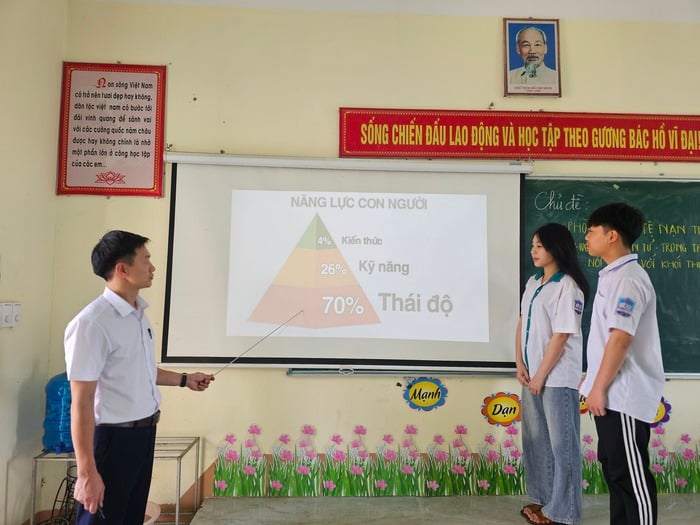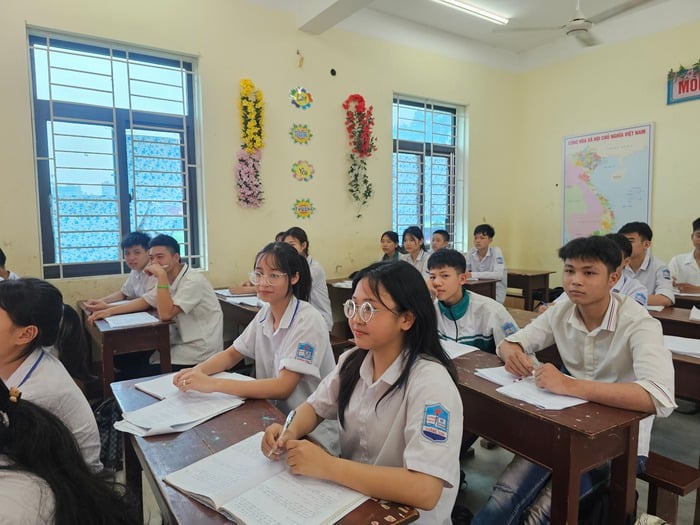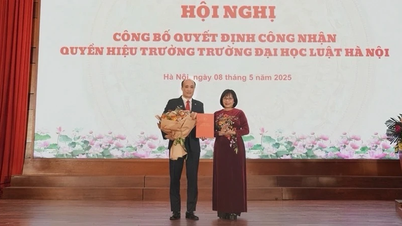Schools are places where knowledge is sown, but they are also a silent frontline against early temptations. For students from grades 6 to 9, when they do not yet understand the harmful effects of cigarettes, especially e-cigarettes, each lesson and each sharing from teachers becomes a lifebuoy. At Thang Son Secondary School (Thanh Son, Phu Tho), the journey "for a smoke-free school" is not just propaganda slogans, but also emotional, haunting and hopeful stories.
The turning point came from a special lesson
"Teacher, I know cigarettes are really harmful. I will quit, I promise," said D, a student in grade 9B. D is not a bad student, he is active and sociable, but he is often tired, late, and rarely participates in class activities. The most noticeable thing is his absent-mindedness during class, as if he is drifting in an unnamed stream, carrying with him the worries of adolescence and secrets he doesn't want anyone to know.

Teacher Dat and students in an extracurricular session on tobacco harm prevention propaganda
Then, a career orientation lesson on the topic of health and healthy living became a turning point for D. In this lesson, the head teacher did not just present dry figures, but also told the story of a former student who was addicted to cigarettes and had gone through a period of struggle to quit. The real story, the real story made the whole class silent. But perhaps the person who was most deeply touched was D.
That afternoon, D quietly went to see the head teacher. He confessed that he had tried smoking a long time ago because his friends challenged him that "not smoking is cowardly". He also talked about the sadness in his family, and a sentence that the teacher could never forget: "I can't continue like this anymore. I want to change".
After that, D gradually changed. She studied more regularly, was less late, and her eyes were less sad. D wanted to take the high school entrance exam at a school near her home to be with her family and continue a new journey, without smoking.
D’s story is not an isolated one. Many teachers at Thang Son Secondary School have discovered students using e-cigarettes. With the appearance of a stylish fountain pen and a pleasant fruity flavor, this drug easily deceives the sense of danger.
Many students mistakenly believe that e-cigarettes are “less harmful,” or even “just for fun.” But in reality, e-cigarettes still contain nicotine, a highly addictive substance, along with many other unregulated toxic substances.
Middle school age, when children are still vulnerable to challenges from friends, academic pressure and lack of knowledge, can easily fall into the trap of "trying it out" and then becoming "addicted to bad things".
Teacher Luong Van Dat, homeroom teacher of class 9B, couldn't help but worry: "I have witnessed a case of a student using an electronic cigarette. Honestly, my first feeling was worry and sadness. I was not really angry, but felt disappointed. Because I know, behind that behavior is often ignorance, being enticed, or finding a way to relieve pressure, or competing with teenagers, like student D."
Help students understand they deserve to live healthy lives
In adolescence, where the ego grows faster than the body, prohibitions are often no longer effective. For teacher Luong Van Dat, educating students about the harmful effects of tobacco, especially e-cigarettes, cannot stop at dry slogans. Each lesson must be a dialogue, each sharing must touch the emotions so that from there, the students can truly absorb and truly change from within.
According to Mr. Dat, the biggest concern today is that electronic cigarettes are increasingly appearing in beautiful packaging: small as a pen, fruity, colorful and modern. It can easily infiltrate the school environment, which is supposed to be the safest place.

Teachers and schools choose flexible but profound propaganda methods to get close to students.
"Some students think that e-cigarettes are "just vapor", not addictive, and do not affect health. They just take a few puffs for fun and to look cool. But they do not know that nicotine is still in it, along with many potentially toxic substances. It is a sophisticated disguise that adults find difficult to distinguish, let alone students who are growing up," Mr. Dat worried.
Mr. Dat believes that the underlying reason why e-cigarettes easily "cross the line" into schools is not only due to students' lack of knowledge, but also due to lax control by families and gaps in the law. Many parents are busy making a living and do not have time to care for their children. Others do not really understand the risks of new-generation cigarettes, thinking that "just trying a little is okay".
Faced with this situation, teachers and schools chose a flexible but profound propaganda method. Instead of just pointing out the harmful effects, teachers told real stories from former students who were addicted and had quit. Lessons integrated into experiential activities, flag-raising hours, paintings with the theme "Say no to cigarettes" hung solemnly in the middle of the schoolyard, all aimed at one goal: Touching the hearts of students.
"What I appreciate most is when I see students proactively sharing, not avoiding it. Once, a former smoker told the whole class about his journey to quit smoking, talking about sleepless nights and the shame he felt towards his parents. That story had a stronger influence than any propaganda article," Mr. Dat shared.
However, talking is not always easy. Many children are still shy, afraid of being judged. They do not admit it, because they are afraid of being criticized. But if you only impose and control, they will avoid it even more. Teachers need to listen, be patient and create a sense of safety.
Mr. Dat affirmed: To effectively prevent tobacco use in schools, we cannot rely on schools alone. We need the coordinated participation of families, communities, and stricter legal regulations on the promotion and disguised marketing of electronic cigarette products.
And most importantly, it is still the students' own choice. "We do not teach to control, but to teach them to understand: Health is the most valuable asset. They deserve to live healthy, happy lives, not dependent on cigarettes or any temptations," Mr. Dat said.
Mr. Dat also said that to effectively prevent the harmful effects of tobacco in the school environment, there needs to be a coordinated and close involvement of family, school and society as well as strict and stringent regulations of the law.
"We don't teach to control, we teach to understand"
Source: https://phunuvietnam.vn/chung-toi-khong-day-de-kiem-soat-ma-day-de-cac-em-hieu-20250506230555313.htm



![[Photo] Prime Minister Pham Minh Chinh meets with the Policy Advisory Council on Private Economic Development](https://vphoto.vietnam.vn/thumb/1200x675/vietnam/resource/IMAGE/2025/5/8/387da60b85cc489ab2aed8442fc3b14a)
![[Photo] President Luong Cuong presents the decision to appoint Deputy Head of the Office of the President](https://vphoto.vietnam.vn/thumb/1200x675/vietnam/resource/IMAGE/2025/5/8/501f8ee192f3476ab9f7579c57b423ad)

![[Photo] National Assembly Chairman Tran Thanh Man chairs the meeting of the Subcommittee on Documents of the First National Assembly Party Congress](https://vphoto.vietnam.vn/thumb/1200x675/vietnam/resource/IMAGE/2025/5/8/72b19a73d94a4affab411fd8c87f4f8d)
![[Photo] General Secretary concludes visit to Azerbaijan, departs for visit to Russian Federation](https://vphoto.vietnam.vn/thumb/1200x675/vietnam/resource/IMAGE/2025/5/8/7a135ad280314b66917ad278ce0e26fa)

















































![[Photo] Prime Minister Pham Minh Chinh talks on the phone with Singaporean Prime Minister Lawrence Wong](https://vphoto.vietnam.vn/thumb/402x226/vietnam/resource/IMAGE/2025/5/8/e2eab082d9bc4fc4a360b28fa0ab94de)
































Comment (0)